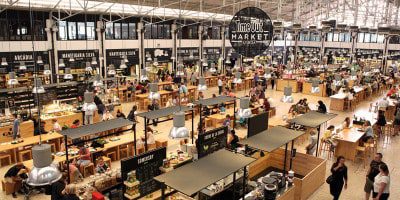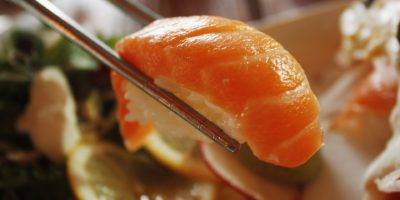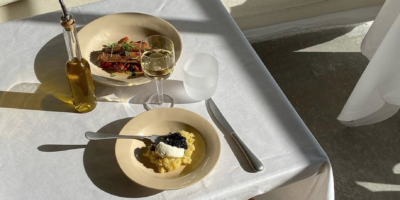20 Colombian Food Traditions That Will Inspire You
Colombian cuisine is a rich tapestry woven from several cultures and centuries of culinary history. Colombia, nestled between the Caribbean Sea and the Andes Mountains, has a diverse range of tastes and gastronomic traditions that delight the palate and feed the spirit.
Colombian gastronomy reflects the warmth and passion of its people, from the ubiquitous arepas that grace morning tables to the savory joys of bandeja paisa that drive festivities. We’ll take a gourmet trip through 20 Colombian cuisine traditions that not only inspire but also provide a flavor of the country’s rich history, ingenuity, and unshakable love for food.
1. Arepa

Photo by Frederick Medina on Unsplash
Arepa is a sort of dish consisting of ground maize dough packed with a filling that has been consumed in northern areas of South America since pre-Columbian times. It is most famous in Colombian and Venezuelan cuisine, although it is also found in Bolivia, Ecuador, and Panama.
The arepa is a flat, round, unleavened patty made with soaking, crushed maize kernels or, more commonly nowadays, maize meal or maize flour. Grilling, baking, frying, boiling, or steaming are all options. Depending on the area, the qualities vary by color, flavor, size, and the food with which it can be packed. Simple arepas are cooked with butter or cheese.
Depending on the meal, extra filling components such as beans, pork, avocados, eggs, tomatoes, salad, and shrimp or fish can be included.Arepas are popular in those nations and can be served with cheese, cuajada (fresh cheese), various types of meat, avocado, or diablito (deviled ham spread). It may also be cut in half to form sandwiches. It is comparable to the Mexican gordita, Salvadoran pupusa, Ecuadorian tortilla de maz, and Panamanian tortilla or changa.
2. Bandeja Paisa

Bandeja paisa, plato Colombiano.jpg Wilfredo Rafael Rodriguez Hernandez, CC0, via Wikimedia Commons
Bandeja is a popular dish in Colombian cuisine, particularly in the Antioquia and Paisa departments, as well as in the Colombian Coffee-Growers Axis, the Valle del Cauca, and the northwest of Tolima.
The generous amount and variety of food in a traditional bandeja paisa are the main characteristics of this dish: red beans cooked with pork, white rice, carne molida (ground meat), chicharrón, fried egg, plantain (plátano maduro), chorizo, arepa, hogao sauce, black pudding (morcilla), avocado, and lemon.
Due to the great amount of food offered, a Paisa platter is generally presented in a big, oval-shaped tray. Mazamorra (a maize-derived beverage similar to atole) with milk and ground panela is served as a side dish.
3. Empanadas

Photo by Delfina Iacub on Unsplash
An empanada is a baked or fried pastry and filling turnover popular in Spanish, other Southern European, Latin American, and Iberian-influenced cultures across the world. The term translates as ‘breaded,’ that is, wrapped or coated in bread, from the Spanish empanar (to bread, i.e., to coat with bread).
They are produced by folding dough over a filling, which can be meat, cheese, tomato, corn, or other ingredients, and then baking or frying the resulting turnover.
The empanada is similar to savory pastries from different cultures, such as molote, pirozhki, calzone, samosa, knish, kreatopitakia, khuushuur, and pasty. The pastry is known as karipap (English: curry puff) in most Malay-speaking nations in Southeast Asia.
4. Sancocho

Photo by Keesha’s Kitchen on Unsplash
Sancocho is Colombian cuisine’s comforting soul, a hearty stew that draws families and communities together. This popular meal exemplifies the country’s unique cultural fabric, fusing indigenous origins with Spanish influences. Sancocho is a boiling cauldron of tastes that often has soft bits of meat, commonly chicken or beef, as well as a variety of potatoes, yuca, maize, and plantains.
It’s a comfort cuisine passed down through generations, bursting with herbs, spices, and affection. Sancocho is a monument to Colombia’s culinary tradition and the friendliness of its people, whether consumed during festivities, family reunions, or as a warming bowl on a rainy day.
5. Lechona
Lechona, a Colombian culinary masterpiece, is a meal that combines history, artistry, and luxury. It’s a whole roasted pig that’s been skillfully seasoned and slow-cooked to crispy, golden perfection. The secret, though, is found within, where the pig is precisely deboned and its cavity is stuffed with a fragrant stuffing of rice, peas, onions, spices, and, occasionally, yellow peas or chickpeas.
Lechona is a celebration, not simply a meal. It represents togetherness and plenty and is frequently saved for special occasions such as weddings, birthdays, and festivals. Friends and family come to enjoy this tasty delicacy, sharing in the delight of Colombian culture and the culinary expertise that has made lechona a beloved tradition.
6. Bunuelos

Photo by Maryam Sicard on Unsplash
Bunuelos, Colombia’s golden orbs, are little, deep-fried beauties that enchant both the young and the young at heart. These crunchy yet fluffy dough balls are created with cheese (queso fresco or cuajada), cornmeal, eggs, and a fragrant spice of anise or vanilla. The dough is then formed into tiny circles and immersed in hot oil until it puffs up and turns a deep, golden color.
Bunuelos are a Christmas and other festive occasion staple in Colombia. They provide a lovely contrast of textures when served hot, with a crispy outer shell giving way to a soft, cheesy inside. Bunuelos, often served with a cup of hot chocolate, are a flavor of Colombian pleasure, tradition, and culture.
7. Natilla
Natilla, Colombia’s sweet and velvety dessert, is a wonderful treat that embodies tradition and festivity. This creamy treat is composed with a few basic but delicious ingredients: milk, sugar, cinnamon, and panela (unrefined cane sugar). These ingredients are gently cooked to create a thick, custard-like consistency suffused with cinnamon’s warm, soothing scent.
Natilla is a beloved dessert, especially around the holidays, when it takes center stage in Colombian families. This delicious treat, which is frequently served alongside bunuelos, brings families together, embodying the spirit of unity and joy. Its velvety texture and sweet, spicy flavor carry Colombians back to their finest moments, enveloped in the embrace of tradition and festivities.
8. Ajiaco

Photo by Alexandra Tran on Unsplash
Ajiaco, a hot bowl of Colombian comfort food, is more than just food; it’s a complex cultural experience. This hearty cuisine hails from Colombia’s capital city of Bogotá, but it has made its way into the hearts and kitchens of Colombians all around the country.
Ajiaco is a chicken soup with soft bits of chicken, three varieties of potatoes (papas criollas, sabaneras, and pastusas), corn on the cob, and a combination of herbs and spices at its heart. The main magic, though, is in the herb guascas, which adds a distinct, earthy flavor to the soup.
Ajiaco is frequently topped with capers, cream, and avocado, creating a symphony of textures and flavors. This dish is more than simply a dinner; it is a celebration of Colombia’s unique agricultural landscape.
9. Pandebono

Pandebono.jpg vasquezcarlosm, CC BY-SA 2.0, via Wikimedia Commons
Pandebono, Colombia’s renowned bread, is a delicious blend of flavors and textures that has won many hearts. This cheesy treat is a mainstay of Colombian bakeries and breakfast tables, hailing from the Valle del Cauca area.
The word “pandebono” refers to “good bread,” and it lives up to that description. These little, golden-brown buns are produced using a simple but magical combination of cornflour, cheese (usually queso costeo or cuajada), eggs, and a touch of starch. As a result, the outside is chewy and somewhat crispy, concealing a gooey, cheesy core.
Pandebono is a flexible snack that may be eaten at any time of day. Its cheesy flavor goes well with a cup of coffee for morning or as an afternoon snack.
10. Chicharrón

Photo by Edgar Soto on Unsplash
Chicharrón, Colombia’s crispy temptation, is a popular snack, which can frequently be seen sizzling at street stalls and local markets, exemplifies the country’s passion of strong and delicious dishes.
Chicharrón is created from thick strips or pieces of pig belly or skin that are deep-fried till crispy and golden brown. The procedure renders the fat, producing a crispy skin that crackles with every mouthful and a soft and savory inside.
This tempting snack can be eaten alone or as a delectable complement to a variety of Colombian cuisine, bringing a pleasant crunch and a blast of rich, savory flavor.
11. Ceviche de Camarones

Photo by silvia trigo on Unsplash
Ceviche de Camarones, a spicy and refreshing coastal cuisine from Colombia, is a delectable monument to the country’s thriving seafood culture. The freshness and quantity of the Caribbean and Pacific oceans are highlighted in this excellent ceviche.
Ceviche de Camarones is made out of exquisite shrimp (camarones) that have been “cooked” by marinating them in an energizing bath of lime or lemon juice. The citrus juice’s acid gradually cures the shrimp, leaving them delicate but somewhat hard.
Colombians add a symphony of flavors to this, such as sliced onions, tomatoes, cilantro, and perhaps a bit of hot pepper for a mild kick. As a consequence, the meal is brimming with vibrant, acidic tastes and a kaleidoscope of textures.
12. Sudado de Pollo
Sudado de Pollo, a hearty and fragrant Colombian cuisine, is a taste symphony that captures the spirit of home-cooked meals. This hearty stew is a favorite for family dinners and informal get-togethers across the country.
Sudado de Pollo’s heart is composed of soft chunks of chicken, frequently on the bone, that are carefully cooked to perfection in a fragrant broth. Tomatoes, onions, garlic, cumin, and other fragrant herbs and spices are commonly used to season the soup.
This combination imparts a deep and flavorful flavor to the chicken, while the lengthy, slow cooking technique guarantees that the flesh is fall-off-the-bone tender. Sudado de Pollo is frequently served over white rice, letting the rice to absorb the stew’s excellent juices and tastes.
13. Tamales

Photo by Tai’s Captures on Unsplash
Tamales are a treasured and time-honored Colombian custom that highlights the country’s rich history and unique flavors. Colombians take pleasure and satisfaction in these exquisite packages of sweetness, which are frequently consumed during special events and celebrations.
Tamales are constructed of a maize masa dough that is then filled with a delicious mixture of meat (usually hog, chicken, or beef), veggies, and spices.
This tasty stew is then wrapped in a banana leaf, carefully knotted, and cooked until tender. The fragrances mingle while the tamale cooks, infusing the masa with the essence of the fillings. Tamales vary in size and content across Colombia, demonstrating the country’s gastronomic variety.
14. Yuca con Mojo
Yuca with Mojo, a simple yet delectable Colombian meal, exemplifies the country’s fondness for root vegetables and robust, spicy tastes. This traditional combination is popular in Colombian cuisine, particularly in coastal areas.
Yuca is a starchy root vegetable that is cooked till soft. It is also known as cassava or manioc. The vivid garlic and citrus mojo sauce that comes with Yuca with Mojo is what sets it distinct. To make the mojo sauce, sauté chopped garlic in olive oil before adding a liberal splash of citrus juice, typically from sour oranges (naranjas agrias) or limes. This combination yields a zesty, fragrant condiment that wonderfully matches the yuca’s mild, somewhat nutty flavor.
15. Arroz con Coco
Arroz with Coco, a tropical delicacy from Colombia’s Caribbean coast, is a seductive mix of tastes that transports you to a gourmet paradise. This meal mixes the richness of coconut with the brightness of Colombian cuisine brilliantly.
Arroz con Coco is essentially a coconut rice meal that starts with white rice cooked in coconut milk. This imparts a gentle, creamy richness and a hint of coconut flavor to the rice.
Shredded coconut is frequently added to the meal to offer texture and a lovely blast of tropical flavour. Arroz with Coco is frequently served as a side dish with seafood, grilled meats, or other regional delicacies.
16. Lulada
Lulada, a cold and pleasant drink from Colombia’s southwestern regions, is like a taste of liquid sunshine on a hot day. This delectable beverage highlights the wealth of tropical fruits available in the nation and provides a rush of tropical taste.
The lulo fruit (also known as naranjilla) is the major component in Lulada. It is native to South America. The acidic and somewhat sweet pulp of the fruit is combined with water, sugar, and ice to make a refreshing and energizing drink.
Lulada is a refreshing drink that offers a lovely blend of acidity and sweetness that tingles the taste senses. This tropical elixir is not only popular among locals, but it is also a symbol of Colombia’s lively and diversified fruit culture.
17. Hormigas Culonas
Hormigas Culonas, or “big-bottomed ants,” are a unique and unusual delicacy found in several Colombian locations. These ants have evolved into a specialized culinary delight, particularly in Santander and other regions of the nation. While many people find the idea of eating ants strange, they are considered a local delicacy and are even honored during festivals.
Typically, ants are gathered at specified periods of the year when they are most prevalent. To improve their flavor, they are properly cleaned, roasted, and seasoned with salt or other spices. Hormigas Culonas are famous for their crisp texture and distinct earthy and nutty tastes.
18. Obleas
Obleas, a delicate and sweet Colombian delight, have charmed both residents and visitors for years. These thin, wafer-like cookies are a popular street food and snack throughout the country, and may be found in plazas, marketplaces, and sweet stores.
Obleas are formed by sandwiching two round, paper-thin wafers with a sweet filling. Arequipe (a caramel-like spread) and jam (typically guava or strawberry) are the most prevalent fillings. The oblea is gently squeezed together once the filling has been poured between the wafers, providing a wonderful contrast of crunchy and creamy textures.
These scrumptious appetizers are more than simply a feast for the palate; they also symbolize the heart of Colombian culture and hospitality. Obleas are frequently shared among friends and family as a symbol of unity.
19. Patacones

Patacones.JPG Jdvillalobos, CC BY-SA 3.0, via Wikimedia Commons
Patacones, also known as tostones in other Latin American nations, are a crispy and flavorful treat that is a staple of Colombian cuisine. These incredibly irresistible flattened and fried green plantains are a popular snack, side dish, or appetizer.
Patacones are created from unripe green plantains that have been chopped into thick circles and cooked twice. The initial fry softens the plantain slices, which are then taken from the oil, flattened, and cooked again until the outside is crispy and golden brown. They are frequently seasoned with salt or other spices during the second cook to improve their taste.
20. Changua

Changua (3279112887).jpg Marcelo Träsel from Porto Alegre, Brasil, CC BY-SA 2.0, via Wikimedia Commons
Changua, a hearty Colombian soup, is a typical morning meal that both warms the spirit and wakes the senses. Changua comes from the Andean area, namely Bogotá, and is noted for its simplicity and nutritious characteristics.
Changua is made from milk, which is commonly blended with water and heated to a moderate simmer. Eggs are broken and poached in this heated liquid, giving the soup its peculiar look of softly cooked, somewhat runny yolks.
The soup is seasoned with a teaspoon of salt and infused with fresh, herbaceous tastes from chopped scallions and cilantro. Changua is often served with slices of old bread that have been soaked and softened in the soup.
To summarize, Colombian cuisine traditions are a tapestry of tastes and culture, with each dish telling a narrative and each bite igniting the senses. From the hearty warmth of ajiaco to the crunchy joy of patacones, these culinary gems invite you to discover Colombia’s rich past. They remind us that food is more than simply nourishment; it is a celebration of tradition, community, and the delight of enjoying life’s moments.
Planning a trip to Paris ? Get ready !
These are Amazon’s best-selling travel products that you may need for coming to Paris.
Bookstore
- The best travel book : Rick Steves – Paris 2023 – Learn more here
- Fodor’s Paris 2024 – Learn more here
Travel Gear
- Venture Pal Lightweight Backpack – Learn more here
- Samsonite Winfield 2 28″ Luggage – Learn more here
- Swig Savvy’s Stainless Steel Insulated Water Bottle – Learn more here
Check Amazon’s best-seller list for the most popular travel accessories. We sometimes read this list just to find out what new travel products people are buying.









